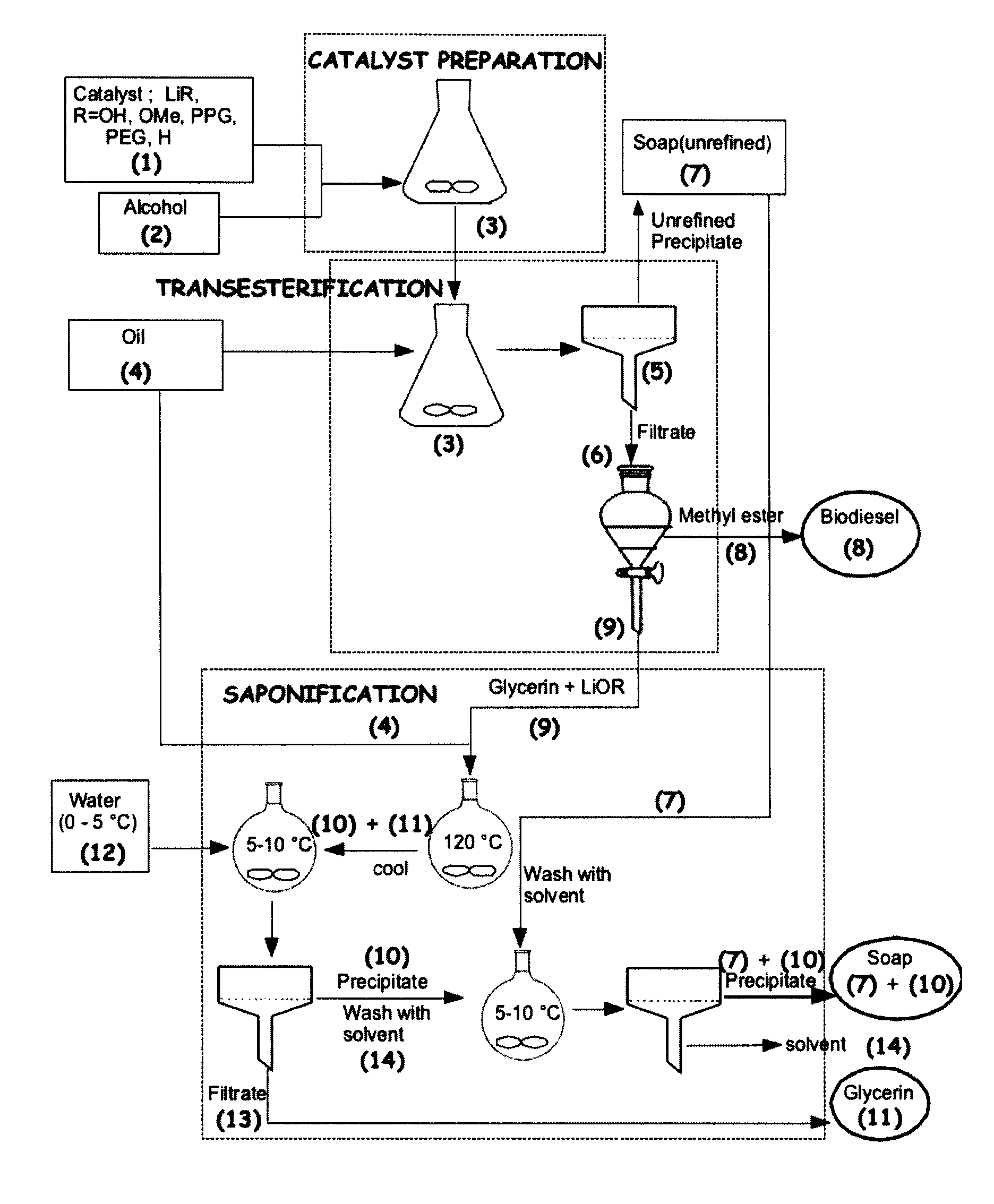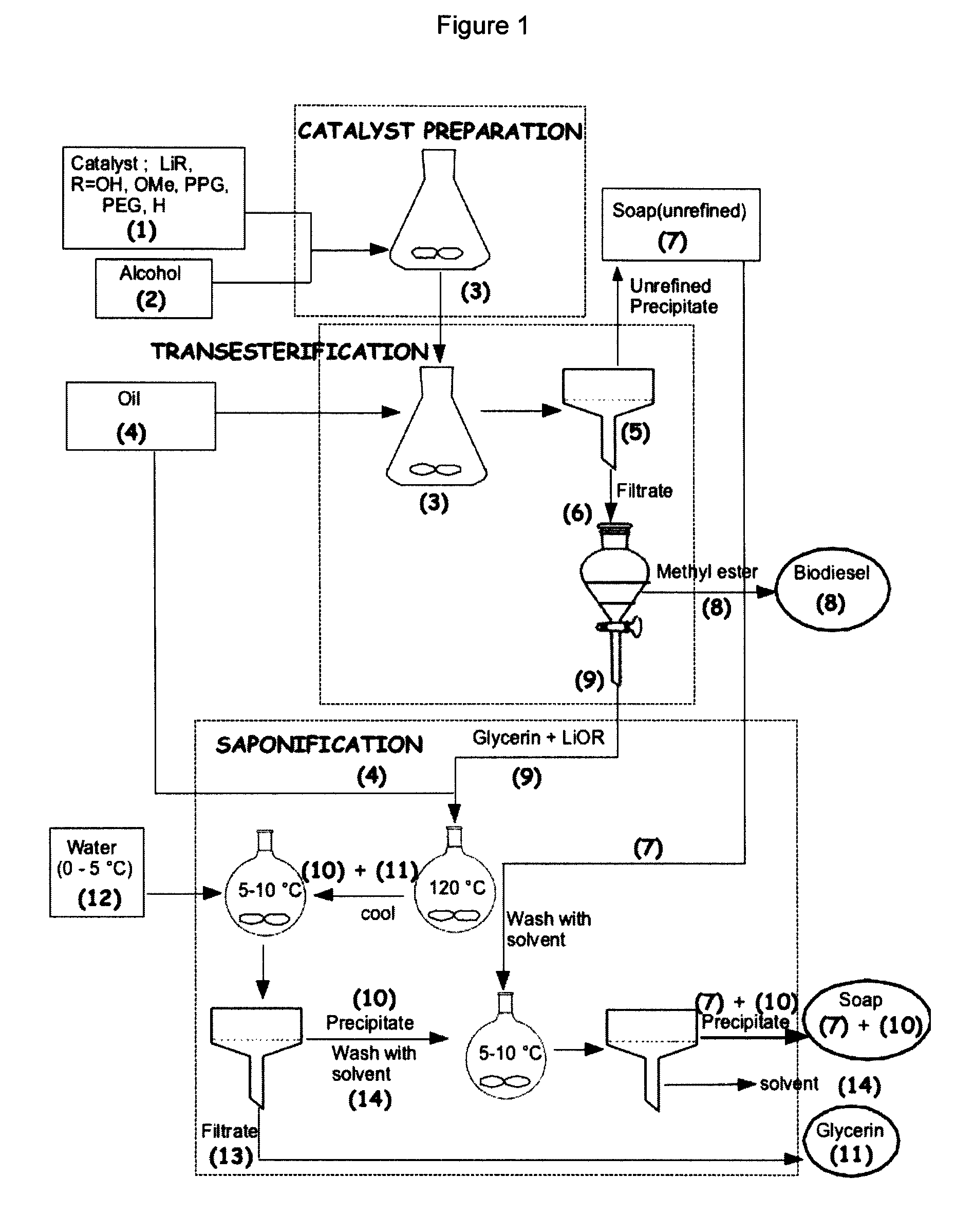Process for the preparation of biodiesel
a biodiesel and fatty acid technology, applied in the field of preparing fatty acid esters (biodiesel), can solve the problems of premature fouling of upper cylinder engine parts, increased fuel viscosity, and poor combustion, and achieve the effect of easy precipitation and removal
- Summary
- Abstract
- Description
- Claims
- Application Information
AI Technical Summary
Benefits of technology
Problems solved by technology
Method used
Image
Examples
example 1
Preparation of Biodiesel, Desalted Glycerin and Lithium Grease in a Two Stage Reaction
Step 1
Preparation of Canola Methyl Ester Using Methanol in the Presence of Monohydrated Lithium Hydroxide
Reaction 1:
[0051]To a clean and dry erlenmeyer flask equipped with a Teflon coated stirring bar were added monohydrated lithium hydroxide (0.4 g, 0.4%) and HPLC grade methanol solution (0.375 mol, 12 g) and the reaction mixture was stirred at room temperature until all the solid dissolves. Mild heat was supplied during dissolution. Commercial canola oil, (0.1 mol, 100 g) obtained from a local grocery store was added to the same flask. All the contents were well mixed and allowed to react for two hours under medium stirring. After 2 hours, agitation was stopped and a uniformly distributed thick precipitation of soap could be observed in the media. The solid soap was filtered under vacuum and the flask contents were transferred to a 200 mL glass separatory funnel. After two hours of separation, tw...
example 2
Preparation of Methyl Ester, Desalted Glycerin and Lithium Grease in the Presence of Monohydrated Lithium Hydroxide Using Higher Quantity of Excess Methanol to Study the Behavior of Solubility of Soap
Step 1
Preparation of Canola Methyl Ester Using Excess Methanol in the Presence of Monohydrated Lithium Hydroxide and Increased Alcohol
Reaction 1:
[0055]To a clean and dry Erlenmeyer flask equipped with a Teflon coated stirring bar were added monohydrated lithium hydroxide (0.4 g, 0.4%) and HPLC grade methanol solution (0.5 mole, 16 g) and the reaction mixture was stirred at room temperature until all the solid dissolves. Mild heat was supplied during dissolution. Commercial canola oil, (0.1 mole, 100 g) obtained from a local grocery store, was added to the same flask. All the contents were well mixed and allowed to react for two hours under medium stirring. After 2 hours, agitation was stopped and a mostly clear solution was observed. The flask contents were transferred to a 200 mL glass...
example 3
Synthetic Process for the Preparation of Biodiesel, Desalted Glycerin and Lithium Grease in the Presence of Monohydrated Lithium Hydroxide in the 1st Reaction and Potassium Hydroxide in the 2nd Reaction
Step 1
Preparation of Canola Methyl Ester Using Methanol in the Presence of Monohydrated Lithium Hydroxide
Reaction 1:
[0059]To a clean and dry Erlenmeyer flask equipped with a Teflon coated stirring bar were added monohydrated lithium hydroxide (0.4 g, 0.4%) and HPLC grade methanol solution (0.375 mol, 12 g) and the reaction mixture was stirred at room temperature until all the solid dissolves. Mild heat was supplied during dissolution. Commercial canola oil, (0.1 mol, 100 g) obtained from a local grocery store was added to the same flask. All the contents were well mixed and allowed to react for two hours under medium stirring. After 2 hours, agitation was stopped and a uniformly distributed thick precipitation of soap could be observed in the media. The solid soap was filtered under v...
PUM
| Property | Measurement | Unit |
|---|---|---|
| temperature | aaaaa | aaaaa |
| temperature | aaaaa | aaaaa |
| alkaline | aaaaa | aaaaa |
Abstract
Description
Claims
Application Information
 Login to View More
Login to View More - Generate Ideas
- Intellectual Property
- Life Sciences
- Materials
- Tech Scout
- Unparalleled Data Quality
- Higher Quality Content
- 60% Fewer Hallucinations
Browse by: Latest US Patents, China's latest patents, Technical Efficacy Thesaurus, Application Domain, Technology Topic, Popular Technical Reports.
© 2025 PatSnap. All rights reserved.Legal|Privacy policy|Modern Slavery Act Transparency Statement|Sitemap|About US| Contact US: help@patsnap.com



